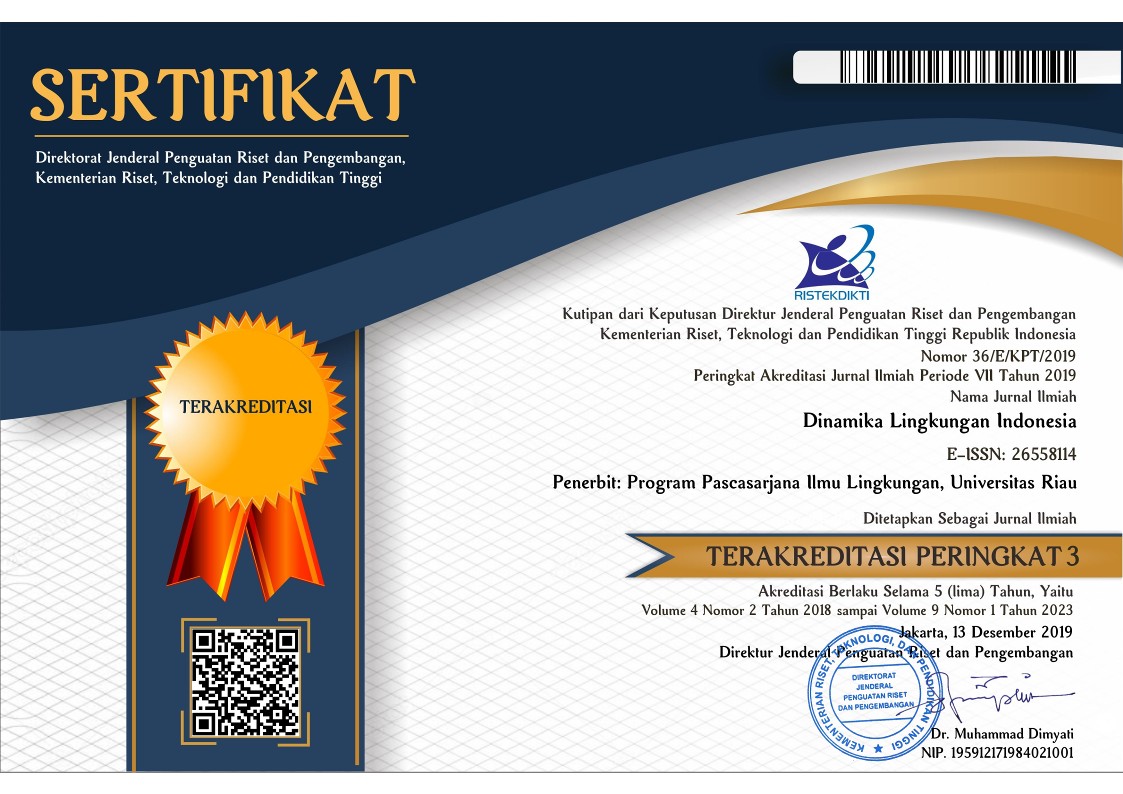Produksi Gas Buangan Ternak Babi yang Diumbar di Gaya Baru dan Sekitar Pasar Wosi, Manokwari
Abstract
The research aims to estimate the manure production and calculate the methane gas produced by the pig free-ranging system in Gaya Baru and the surrounding of Wosi Market in Manokwari. This research is conducted from May to June 2018. The methods used in this study are observation, interviews, and literature study. Direct observations in the field are carried out by calculating the pig population and estimating the body weight by measuring body length and chest circumference according to the Winter formula. Furthermore, the calculation of the amount of fresh dung (KTS) of pigs is carried out. The parameter observed in this research is the methane gas produced by the systems. Research is conducted by observation, interview, and literature review with a descriptive statistical approach. The free-ranging pig systems in Gaya Baru and its surroundings produce ammonia at 0.246617 ppm/day, biogas of 10.95m3/year, equivalent to 3996.75m3 per year, and methane of 10.85 m³ per day, or equivalent to 130.18 m³ per year. If this condition is allowed to continue, this will have a social impact, but also environmental and health problems around the research sites.
Keywords
Full Text:
PDFReferences
Agri Forum, (2011). Cara Mudah Usaha Ternak Babi. Cahaya Atma Pustaka, Yogyakarta.
Armstrong, T.A., Williams, C.M., Spears, J.W., & Schiffman, S.S. (2000). High dietary copper improves odor characteristics of swine waste. Journal of Animal Scienc,e 78: 859-864. https://doi.org/10.2527/2000.784859x.
Chynoweth, D.P., Wilkie, A.C., & Owens, J.M. (1999). Anaerobic treatment of piggery slurry. Asian-Aus Journal of Animal Science, 12(4): 607-627. https://doi.org/10.5713/ajas.1999.607.
Dewi, G.S., Sutaryo, & Purnomoadi, A. (2014). Produksi dan Laju Produksi Gas Methan Pada Biogas dari Feses Sapi Madura Jantan Yang Mendapatkan Pakan Untuk Produksi Yang Berbeda. Animal Agriculture Journal 3(4): 538-543. https://ejournal3.undip.ac.id/index.php/aaj/article/view/11625.
Ditjen Peternakan dan Kesehatan Hewan. (2013). Pedoman Teknis Budidaya Ternak Babi. Kementerian Pertanian Direktorat Jenderal Peternakan dan Kesehatan Hewan. Jakarta.
Engler C. R, Jordan, E.R., Mc Farland, M.J., & Lacewell, R.D. (2012). Economics and environmental impact of biogas production as a manure management strategy. Files.harc.edu/gulfcoastchp/ publications/economicimpactbiog asproduction.pdf.
Firman, A. (2011). Animal Unit (AU), Cara Menghitung Kapasitas Tampung dari Suatu Areal Penggembalaan, Kapasitas Tampung Padang Pengembalaan, Nilai Konversi ST Atau AU Pada Berbagai Jenis dan Umur Fisiologis Ternak., Satuan Ternak (ST). https://adifirman.wordpress.com/2011/11/21/satuan-ternak-st-animal -unit-au/ diakses pada tanggal (21 November 2011).
Guntoro S. (2011). Saatnya Menerapkan Pertanian Tekno-Ekologis Sebuah Model Pertanian Masa Depan untuk Menyikapi Perubahan Iklim, Agromedia Pusataka, Jakarta.
Haryanto, (1997). Kotoran Ternak dan Bahayanya Sebagai Polutan Udara. Invovet Edisi 049: 35-36.
IPCC [Intergovernmental Panel on Climate Change]. (2006). IPCC Guidelines for National Greenhouse Gas Inventories Vol. 2: Energy; Chapter 2: Stationery Combustion. Washington D.C, USA.
KP4 UGM – Kebun Pendidikan, Penelitian dan Pengembangan Pertanian UGM. (2012). Bio Gas - Materi Tayang Tim KP4 Universitas Gajah Mada, Jogyakarta.
Marani, O. (2004). Sistem Pemeliharaan Ternak Babi oleh Suku Arfak di Kampung Gaya Baru Kelurahan Wosi. Distrik Manokwari Barat. Skripsi. Fakultas Peternakan dan Ilmu Kelautan. Universitas Negeri Papua.
Pattiselanno, F. (2004a). Babi Hewan Ternak Penggembur Tanah. SALAM 6(14).
Pattiselanno, F. (2004b). Preliminary study on traditional pig raising by local communities at upland Kebar, Manokwari, West Papua. Suiform Soundings, 4(1): 19-20.
Pattiselanno. F. & Iyai, D A. (2005). Peternakan Babi di Manokwari: Mempertahankan Tradisi dan Meningkatkan Taraf Hidup. SALAM. 3: 24-25.
Putri, A.A.I.K., Asmara, I.W.S., & Aryana, I.K. (2014). Pengaruh jenis kotoran terhadap kuantitas biogas. Jurnal Kesehatan Lingkungan 4(1): 45-49.
Rohaeni, E.S. (2005). Dampak Pencemaran Lingkungan dan Upaya Mengatasinya. Poultry Indonesia 299: 58-61.
Santi, (2006). Pengaruh suhu dan C/N Rasio terhadap produksi biogas berbahan baku organik, Universitas Gajah Mada, Yogyakarta.
Seseray, D. & Bawole, R. (2015). Persepsi dan Evaluasi Keberhasilan Penertiban Hewan/ Ternak Babi di Kabupaten Manokwari. Policy Brief Majalah Jaringan Peneliti Kawasan Timur Indonesia Bakti.
Sofia, P. (2010). Artikel Pencemaran Limbah Ternak Babi Terhadap Kualitas Lingkungan Hidup.
Shin (2008). Predicting Methane Production Potential of Anaerobic Co-digestion of Swine Manure and Food Waste. Environmental Engineering Research 13 (2): 93-97. https://doi.org/10.4491/eer.2008.13.2.093.
Sugiyono (2003). Statistik Untuk Penelitian. CV. Alfabeta, Bandung.
Umar (2017). Metode Penelitian untuk Skripsi dan Tesis Bisnis. Raja Grafindo Persada, Jakarta.
United Nations (1984). Update Guidebook on Biogas Development-Energy Resources Development Series. No. 27. New York: USA.
Wahyuni, S. (2011). Menghasilkan Biogas dari Aneka Limbah, Jakata, Agromedia Pustaka.
Zalizar, L., Relawati, R., & Ariadi B.Y. (2013). Potensi produksi dan ekonomis biogas serta implikasinya pada kesehatan manusia, ternak dan lingkungan. Jurnal Ilmu-ilmu Peternakan 23(3): 32-40.https://jiip.ub.ac.id/index.php/jiip/article/view/132.
DOI: http://dx.doi.org/10.31258/dli.10.1.p.19-28
Refbacks
- There are currently no refbacks.

This work is licensed under a Creative Commons Attribution 4.0 International License.





